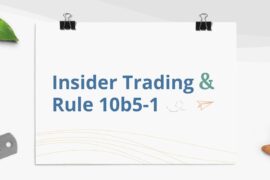Introduction
Demystifying SEC Rule 10b5-1 will take you on a journey through the complexities of such a rule. To help readers better understand the complexities of insider trading legislation, this page provides a helpful navigational guide. Gain a deep comprehension of trading plans and how they conform to SEC Rule 10b5-1, and uncover their relevance. Investors, financial experts, and lawyers will all find this tutorial useful for understanding the nuances of insider trading. Read More on Insider Trading Org for a comprehensive examination of SEC Rule 10b5-1 and insider trading rules. Acquire knowledge to empower yourself and confidently manage the financial landscape.
Understanding Rule 10b5-1
Rule 10b5-1’s Origins And History
For the purpose of revising Rule 10b-5 of the Securities Exchange Act of 1934, the SEC promulgated Rule 10b5-1 in the year 2000. To ensure that corporate insiders can trade their stocks on a predetermined schedule without facing insider trading charges, Rule 10b5-1 was put into place. To keep the financial markets open and equitable, it is an essential regulatory tool.
Insiders’ Sale Of Company Stock Through Trading Plans
Under Rule 10b5-1, insiders (such as directors, officers, and major shareholders) of publicly traded corporations can arrange to sell a specific number of shares at a given time. Insiders can diversify their investments or pay off debts with these arrangements in place, and they won’t have to worry about charges of trading on MNPI. Trading plans are like a contract between an insider and their broker; they lay out all the details of the trades ahead of time.
Avoiding Allegations Of Insider Trading Is Crucial
Rule 10b5-1 is important because it allows insiders to trade company stocks in a controlled and legal way, protecting them from insider trading accusations. Anyone accused of engaging in insider trading, as well as the companies they work for, might face serious legal and public relations repercussions. The financial markets as a whole benefit from insiders’ dedication to honest and lawful trading which is shown when they follow Rule 10b5-1.
Rule 10b5-1 Plan Requirements
Elements Necessary For An Effective Rule 10b5-1 Strategy
A Rule 10b5-1 plan can only be considered legitimate and in line with insider trading rules if it fulfills certain requirements. Here are the criteria:
Details on the Amount, Sales Dates, and Prices: You need to include the amount of securities to be traded, the dates for the transactions, and the price in the plan.
Quantification or Formula: The strategy should include a set of measurements or a formula that governs the determination of the amount, pricing, and sales dates. Because of this, the trading decisions are made with more objectivity.
Broker-Only Privileges: Unless they have access to substantial nonpublic information (MNPI) at the moment of execution, the broker having exclusive rights to conduct the sales or purchases must be able to decide when to execute the trades.
Details Regarding The Amount, Price, And Sales Dates
For each scheduled transaction, the Rule 10b5-1 plan must include the exact amount of securities, the date of the transaction, and the price at which the shares will be bought or sold. To guarantee that the insider’s access to MNPI does not affect the predetermined trading activity, this degree of specificity is essential.
Protecting Highly Confidential Information
Rule 10b5-1 forbids trading based on substantial nonpublic information, which is perhaps its most important component. A Rule 10b5-1 plan may only be set up or changed by an insider if they do not have any material nonpublic information (MPI) about the firm or its securities. The purpose of this regulation is to keep the financial markets open and fair by discouraging insiders from using secret knowledge for their benefit.
Amendments To Rule 10b5-1in Insider Trading Regulations
Proposed Sec Regulations In December 2022
Significant changes to the regulation of insider trading were made by the U.S. Securities and Exchange Commission (SEC) in December 2022 with the implementation of revisions to Rule 10b5-1. After twenty years of criticism, some believe insiders could use liability rules to trade with nonpublic information, which is why the regulation was amended to address these concerns. Notable modifications comprise:
Cooling-Off Period
Directors and executives are now required to wait for 90 days after a plan is adopted or modified, or for two business days after the final fiscal quarter results are disclosed in a Form 10-Q, Form 10-K, Form 20-F (for foreign private issuers), or Form 6-K, due to a cooling-off period instituted by the SEC. Before any trading activity can begin under the Rule 10b5-1 plan, this period must not exceed 120 days.
Certification Requirement
Now, when a Rule 10b5-1 plan is adopted or amended, directors and officers must affirm that they are unaware of any substantial nonpublic information (MNPI) about the issuer or its securities. A formal commitment to compliance must be ensured by including this certification within the Rule 10b5-1 plan itself.
Confidentiality Obligation
The new modifications make it clear that insiders must act in good faith concerning their Rule 10b5-1 plans to use the affirmative defense. This goes against the initial suggestion that plans be “operated in good faith.”
Gifts Of Securities And Stock Trades Must Now Be More Openly Disclosed
To bring more openness to stock trades and gifting of securities, the revisions also brought stronger disclosure requirements. Here are the changes:
Clearer And More Regular Disclosure
Now, issuers have to disclose every quarter if directors and officers have adopted or terminated any trading arrangements that aren’t Rule 10b5-1 plans, as well as any other trading arrangements that aren’t. Forms 10-Q, 10-K, 20-F (for foreign private issuers), or 6-K must contain this disclosure, which must contain important terms but not pricing information.
Transparency In Reporting On Insider Trading
With the option to attach a copy of the policy to their Form 10-K or Form 20-F, issuers are required to disclose annually if they have implemented insider trading policies or processes.
Announcement Of Equity Award Timing Procedures
To tackle the issues of “spring-loading” and “bullet-dodging,” a new provision in Regulation S-K, Item 402(x) requires that annual reports and proxy statements include narrative disclosure about the policies and practices regarding the timing of stock options, stock appreciation right, or similar award grants concerning the release of MNPI.
Examining Directors And Officers And Their Cooling-Off Periods
The changes include new certification standards and a cooling-off period for directors and officers. A waiting period between the adoption or revision of a plan and the start of trade is ensured by the cooling-off period. As part of the certification process, directors and officers must officially acknowledge that they are not familiar with MNPI and pledge to implement or amend the plan in good faith.
Effect On Current Rule 10b5-1 Strategies
Existing Rule 10b5-1 plans that were entered into before the effective date of the final regulations will remain unaffected, as clarified by the modifications. The additional rules, however, will apply to any changes made to the basic terms of these plans after the effective date. That way, we can keep our current plans in place while also keeping up with regulatory changes.
Rule 10b5-1’s Objective
Insiders’ Right To Sell Company Stock With Confidence
For those who work inside a company, Rule 10b5-1 provides a legal shield that allows them to sell shares without being accused of insider trading. By protecting insiders from being unfairly punished for having nonpublic information, this defense is essential for keeping the financial markets functioning properly and enabling them to participate in scheduled, pre-planned transactions.
Affirmative Defense Relying On Certification Requirements And Conditions
The affirmative defense offered by Rule 10b5-1 is subject to certain certification criteria, which insiders must meet. Adopting or revising a Rule 10b5-1 plan requires certain certifications, one of which is that the issuer or its securities were not the subject of any material nonpublic information when the certification was made. Furthermore, insiders must behave in good faith concerning their Rule 10b5-1 plans, as emphasized in the revised rules.
How It Affects Large Shareholders, Directors, And Senior Officers
A variety of insiders are subject to Rule 10b5-1, including directors, senior officials, and persons or entities possessing greater than 10% of the voting shares of the corporation. This widespread application guarantees that highly influential individuals with access to nonpublic information adhere to a prescribed procedure when trading the stocks of their company. The rule’s stated goals include encouraging major stakeholders in publicly traded corporations to be fair, and transparent, and to comply with insider trading prohibitions.
Impact By Rule 10b5-1
Directors, senior officials, and entities with significant ownership interests are among the many groups affected by Rule 10b5-1, which applies to publicly traded firms. The purpose of the rule is to establish norms for these important players to follow when trading, to prevent insider trading and to make sure everything is open and fair.
Relevance To Current And Former Employees Of Publicly Traded Companies
People who are linked with a corporation and have access to material nonpublic information (MNPI) are considered insiders and are thus subject to Rule 10b5-1. Everyone in the company, from executives to workers, is considered important persons if they have knowledge that could affect the stock value, such as the company’s financial performance, strategic decisions, or anything else. Rule 10b5-1 seeks to ensure that all investors are on an equal footing by controlling the trading activity of these insiders and thereby preventing the abuse of privileged information.
Corporate Members, Executives, And Organizations Holding More Than 10% Voting Shares
Directors
A director is expressly included in the purview of Rule 10b5-1. Insights into the organization’s future goals and performance are frequently held by directors, who are entrusted with decision-making and governance responsibilities inside the corporation. The rule’s stated goal of regulating directors’ actions through the formation of specified trading plans is based on the recognition that directors’ trading activity can considerably impact the market.
Senior Officers
Executives at the senior level, including the chief executive officer, chief financial officer, and chief operating officer, play a crucial role in setting the overall direction and running of a corporation. Because of their positions of authority, senior executives are probably aware of MNPI. To promote ethical behavior in the financial markets and prevent the potential exploitation of sensitive information, Rule 10b5-1 acknowledges the need to control the trading activities of senior officials.
Organizations Holding More Than 10% Of The Voting Shares
Rule 10b5-1 applies to entities, including major shareholders or institutional investors, that possess more than 10% of a company’s voting shares. The decisions made by the corporation are frequently swayed by these entities, and they may even have access to important data. To ensure that all market participants are treated fairly and have equal opportunity, the regulation regulates their trading actions in a way that prevents any unfair advantage that could be achieved by the strategic use of nonpublic information.
Conclusion
The intricate rules and restrictions governing insider trading are effectively explained in Insider Trading Org’s thorough introduction to SEC Rule 10b5-1. Trading plans are crucial for assuring compliance with SEC Rule 10b5-1, which the piece deftly navigates. Investors, executives, and legal professionals looking for a detailed understanding of regulatory frameworks will find this guide an excellent resource thanks to its straightforward and informative summary. Compliance with SEC Rule 10b5-1 is becoming more and more important as the financial environment changes. A guiding light, the Insider Trading Org manual shows the way to legitimate and ethical trading within the bounds of this vital regulatory framework.


